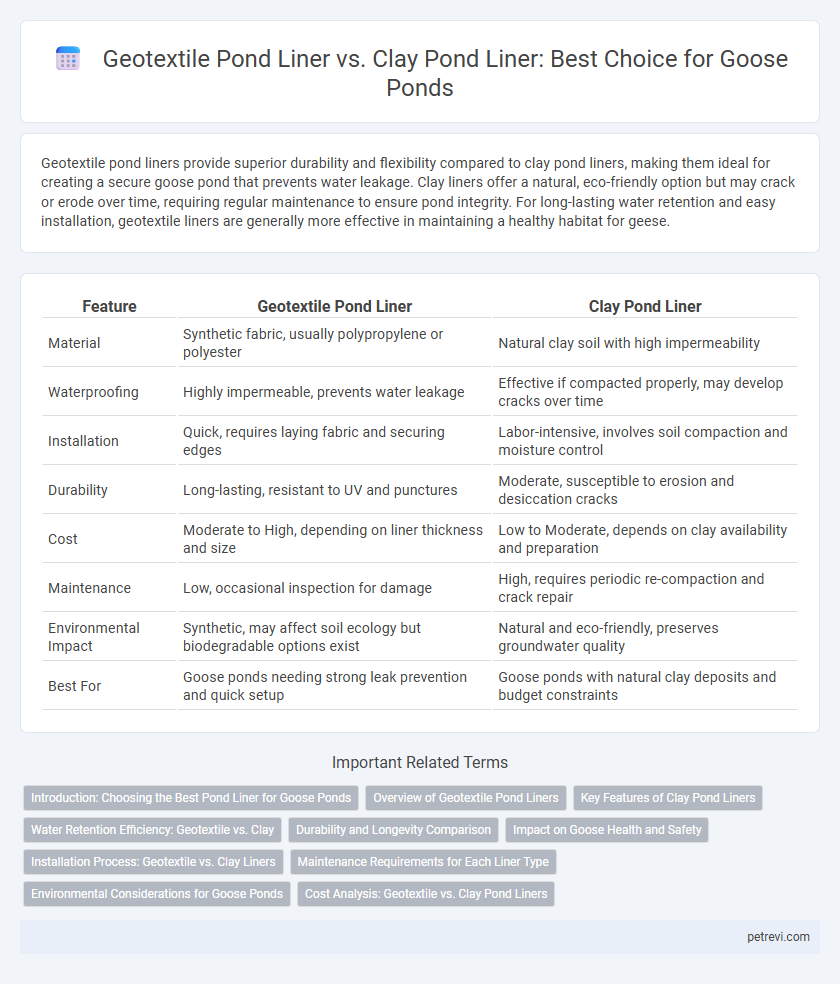Geotextile pond liners provide superior durability and flexibility compared to clay pond liners, making them ideal for creating a secure goose pond that prevents water leakage. Clay liners offer a natural, eco-friendly option but may crack or erode over time, requiring regular maintenance to ensure pond integrity. For long-lasting water retention and easy installation, geotextile liners are generally more effective in maintaining a healthy habitat for geese.
Table of Comparison
| Feature | Geotextile Pond Liner | Clay Pond Liner |
|---|---|---|
| Material | Synthetic fabric, usually polypropylene or polyester | Natural clay soil with high impermeability |
| Waterproofing | Highly impermeable, prevents water leakage | Effective if compacted properly, may develop cracks over time |
| Installation | Quick, requires laying fabric and securing edges | Labor-intensive, involves soil compaction and moisture control |
| Durability | Long-lasting, resistant to UV and punctures | Moderate, susceptible to erosion and desiccation cracks |
| Cost | Moderate to High, depending on liner thickness and size | Low to Moderate, depends on clay availability and preparation |
| Maintenance | Low, occasional inspection for damage | High, requires periodic re-compaction and crack repair |
| Environmental Impact | Synthetic, may affect soil ecology but biodegradable options exist | Natural and eco-friendly, preserves groundwater quality |
| Best For | Goose ponds needing strong leak prevention and quick setup | Goose ponds with natural clay deposits and budget constraints |
Introduction: Choosing the Best Pond Liner for Goose Ponds
Geotextile pond liners offer superior durability and resistance to punctures, making them ideal for protecting goose ponds from leaks and erosion. Clay pond liners provide a natural, eco-friendly barrier that retains water effectively but may require regular maintenance to prevent cracking or drying out. Selecting between geotextile and clay liners depends on factors such as soil type, budget, and long-term pond sustainability for goose habitats.
Overview of Geotextile Pond Liners
Geotextile pond liners provide superior protection for goose ponds by offering high durability, resistance to punctures, and effective water retention compared to traditional clay liners. These synthetic materials allow for efficient drainage and root resistance, preventing seepage and ensuring a stable pond environment. Geotextile liners require less maintenance, making them an environmentally friendly and cost-effective solution for sustainable goose pond management.
Key Features of Clay Pond Liners
Clay pond liners offer natural impermeability due to their fine particle structure, effectively preventing water seepage in goose ponds. Their environmental compatibility supports sustainable pond ecosystems, promoting healthy goose habitats without introducing synthetic materials. The adaptability of clay liners to uneven pond surfaces ensures a secure seal, reducing maintenance efforts and enhancing pond durability.
Water Retention Efficiency: Geotextile vs. Clay
Geotextile pond liners offer superior water retention efficiency for goose ponds by providing a durable, impermeable barrier that minimizes seepage and maintains consistent water levels. Clay pond liners rely on natural compaction, which can be less reliable due to potential cracks and permeability issues, leading to higher water loss over time. Choosing geotextile liners enhances water conservation, reduces maintenance needs, and supports a stable aquatic habitat essential for geese.
Durability and Longevity Comparison
Geotextile pond liners offer superior durability for goose ponds due to their resistance to punctures and UV degradation, ensuring long-lasting performance in diverse weather conditions. In contrast, clay pond liners, while natural and cost-effective, are prone to erosion and cracking over time, leading to frequent maintenance. The enhanced longevity of geotextile liners makes them a more reliable choice for maintaining a stable and secure habitat for geese.
Impact on Goose Health and Safety
Geotextile pond liners provide a durable, non-toxic barrier that prevents water contamination, reducing the risk of harmful bacteria and pollutants affecting goose health. Clay pond liners, while natural, can crack and allow contaminants to seep through, potentially exposing geese to unsafe water conditions. The impermeability and resistance to punctures of geotextile liners offer enhanced safety, minimizing the risk of injury or exposure to hazardous substances for geese.
Installation Process: Geotextile vs. Clay Liners
Geotextile pond liners offer a faster and more straightforward installation process compared to clay liners, as they are pre-manufactured and can be quickly laid out and secured in the goose pond area. Clay liners require extensive site preparation, including soil compaction and moisture control, to create a natural seal that prevents water leakage. The flexibility and ease of handling geotextile liners reduce labor costs and installation time, making them a practical choice for managing goose ponds efficiently.
Maintenance Requirements for Each Liner Type
Geotextile pond liners require minimal maintenance as they are durable, resistant to punctures, and prevent water seepage, reducing the need for frequent repairs in a goose pond. Clay pond liners demand regular upkeep, including periodic re-compaction and monitoring for cracks or erosion caused by natural weathering and goose activity. Proper maintenance of geotextile liners ensures long-term water retention with less labor, while clay liners may increase ongoing maintenance efforts to sustain pond integrity.
Environmental Considerations for Goose Ponds
Geotextile pond liners offer superior environmental benefits for goose ponds by preventing water seepage and reducing soil erosion, thereby maintaining natural habitats without introducing harmful chemicals. Clay pond liners rely on natural soil compaction but can be vulnerable to cracking and water loss, potentially disrupting local ecosystems and increasing maintenance needs. Using geotextile liners supports water conservation and preserves the surrounding flora and fauna, essential for sustaining healthy goose populations.
Cost Analysis: Geotextile vs. Clay Pond Liners
Geotextile pond liners typically offer a lower initial cost compared to clay liners due to reduced material and installation expenses, making them a cost-effective option for creating durable goose ponds. Clay pond liners, while more labor-intensive and expensive upfront, provide natural impermeability and long-term resilience, potentially lowering maintenance costs over time. Evaluating the total cost of ownership for goose pond projects highlights geotextiles as budget-friendly short-term solutions, whereas clay liners can be more economical for long-lasting applications.
Geotextile pond liner vs Clay pond liner for Goose pond Infographic

 petrevi.com
petrevi.com